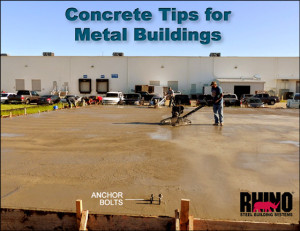Constructing a Steel Building on a Firm Foundation
As with any structure, foundations for steel framed buildings need to be firm and made right.
First-rate concrete slab, pier, or perimeter wall promises solid support for the lives of the structures. Steel building foundations poured with poor-quality concrete promise nothing but problems.
Don’t Cut Corners on Concrete Foundations
 Many do-it-yourselfers consider themselves capable of pouring their own metal building foundations. They poured the cement for their fence posts, didn’t they? And one summer they helped Uncle Bob pour the floor for his 6’ x 8’ tool shed. So what is the big deal?
Many do-it-yourselfers consider themselves capable of pouring their own metal building foundations. They poured the cement for their fence posts, didn’t they? And one summer they helped Uncle Bob pour the floor for his 6’ x 8’ tool shed. So what is the big deal?
The big deal is QUALITY.
Foundations for steel framed buildings are designed, engineered, and manufactured to exact tolerances.
There is no room for error in a metal building.
Foundations for steel buildings need to be precise in size. The foundation walls must be straight. The slab must be squared. The connections have to align perfectly, so all the framing connects and squares correctly. Corners should be crisp. The tops of the foundations should be level and straight.
For professional results, let a qualified professional concrete contractor do the job.
The local concrete company will have a list of concrete contractors available.
What You Need to Know About Metal Building Foundations
Here are a few tips to consider when pouring slabs, piers, or perimeter walls for steel buildings:
- Cement and concrete are not the same thing. Cement holds concrete together. Cement, sand, gravel, and water mixed together create concrete.
- Concrete is purchased by the cubic yard. A concrete engineer determines the amount of concrete needed, based on your metal building plans, the projected weight of vehicles or heavy equipment used in the structure, local soil conditions and building codes.
- If soil conditions are poor, you may find it less expensive to bring in a better grade of dirt than to pour a deeper foundation for a large steel structure. Discuss this possibility with your concrete contractor or engineer.
- If possible, do not plan to pour foundations for steel framed buildings in the dead of winter. Concrete cures best when poured between 45° and 90° Fahrenheit.
- Frost heave may crack curing concrete foundations. If the temperature plummets below freezing in the first 24 hours after pouring, the concrete may lose as much as half of its projected strength.
- Allow plenty of time for the foundation to cure completely. Plan the arrival of your steel building a minimum of three days after the pouring of foundations in warm weather. For best results, allow the concrete to dehydrate for two weeks or more.
- The colder the weather, the longer it takes a foundation to cure completely.
- Building on a slab that is not completely dehydrated sometimes causes condensation within the structure. That is a lot bigger problem that you may think. A 5,000 sq. ft. concrete slab poured 4” deep may produce over 1,200 gallons of water vapor inside the structure! During winter construction, proper ventilation is paramount. Leave a few exterior steel panels off until the foundation cures completely.
- You have no doubt seen those ultra-fast construction jobs on “Extreme Makeover: Home Edition.” Chemical accelerators mixed into the concrete speed drying time on some of these projects. However, avoid using the additive calcium chloride for your building foundation. It is extremely corrosive to the steel in the foundation.
- Set your anchor bolts with templates to assure correct location in the slab. Check all the anchor bolts again immediately after installation of the concrete to be sure the bolts remained straight and true.
Ask the Experts at RHINO
Contact RHINO now for more information on steel building foundations. Our experienced metal building specialists will gladly answer all your questions. Call RHINO today, at 940.383.9566 for info on foundations for steel framed buildings.
